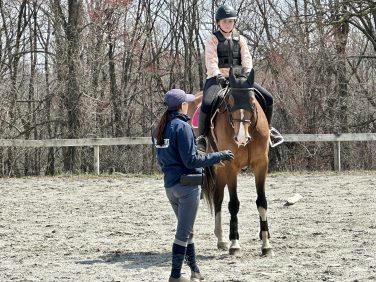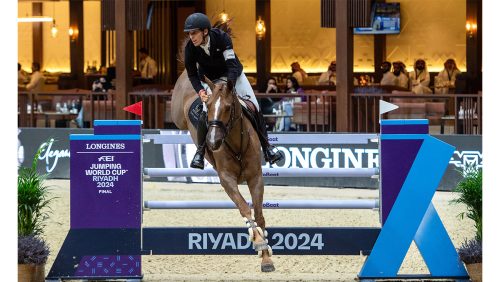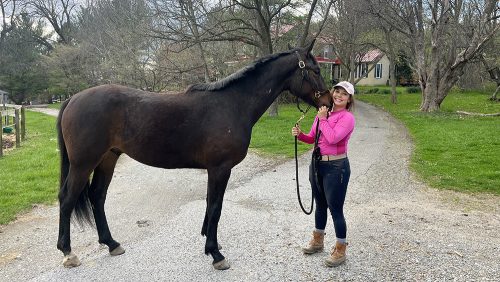Dear Rita,
Many people have wondered about my motivation in writing this particular blog about the future of American dressage as I envision it. Some people have labeled it as self-promotion, although most have viewed it as political suicide to speak out against the old, established way of doing things. Some people think I’m interested in coaching or managing the team. However, none of these assumptions is correct from my own perspective.
My motivation is singular: to help competitive dressage in my own country morph into a force to be reckoned with worldwide. Why? Because I want to be part of that force. I have spent 20 years in Europe, Rita. If I do not share all that I have learned from my experiences here, the last two decades of my life will have been for naught. So, I’m putting my opinion out there and hoping it may be of some use in spurring the entire industry FORWARD in America.
Having said that, we need to move on to the fourth and final element that I believe is crucial to developing a world-class dressage team: Marketing and Finance.
Paying for the development of a contemporary, successful U.S. dressage team isn’t going to be easy. We have to start with a proposed plan and then find a way to come up with the money for it. The task seems daunting, but for me it’s just another challenge.
I moved to Germany in 1993 with $3,000 in the bank, three credit cards, two average horses and one bicycle. After 20 years of training and showing in the heart of Germany’s competitive horse industry, I am returning to the USA with $3,000 in the bank, three international Grand Prix prospects, two dogs and string of successes in international sport. I believe that if I can achieve something so unlikely, we citizens of the U.S. dressage industry can put our heads together and find a way to finance our sport in America.
4. Marketing and Finance
Obviously funding is the major hurdle to the development of any Olympic sport and in particular the dollar-intense equestrian sports. I am sure that anyone in charge of developing a team for 2014 and 2016 would love to follow the plan I laid out in my last blog IF funds for dressage were unlimited. Unfortunately, we are weakly funded which makes the position of marketer/fundraiser one of the most important for a strong future dressage team. We need a professional in this position whose job is to MAKE THE MONEY WE NEED TO SPEND for success.
Let’s be clear on one thing. All the dues and fees we pay to the U.S. Equestrian Federation go to covering the expenses of the USEF. Private donations to the U.S. Equestrian Team Foundation currently provide the only avenue of team support for the seven high performance disciplines, although I’m not sure what percentage of donation income actually makes it to dressage.
In 2011, the USET appropriated $2.1 million to the USEF for support of all high performance disciplines. In 2012, the USET will make $2.7 million available for high performance use. God bless the ladies and gentlemen at the USET for busting their butts to raise those funds. Up until this point, they’ve been our only source of support.
But frankly, Rita, $2 million is what private sponsors spend on one horse in Europe, not the development of seven disciplines. So yes, we do have a problem.
Most private donors to the USET are interested in horses and equestrian sports. Many of them are the vital private sponsors who purchase top horses for our top competitors. If we could relieve them of supporting our teams with donations, perhaps these private donors could turn more money toward the purchase of future mounts.
Finding a neutral source of team support would level the playing field for all competitors. In our current system, when a top donor to the sport enters his personal horses in Olympic qualifications, this creates the perception that his horse could be favored for team selection—a conflict of interest that becomes the elephant in the room at every selection trial, especially in dressage.
Now Rita, I personally believe that very few riders and horses have gotten on our teams due to the influence of their owners. Everybody has to produce real results to get on a team.
ADVERTISEMENT
That said, when it comes down to choosing who to put on a team, it makes financial sense to choose the horse owned by the private donor when your team has no other means of support. Whether this actually occurs or not is irrelevant. The perception that it occurs makes it a reality to be dealt with, which is the basic nature of all conflicts of interest.
The solution, of course, is to find other ways to fund our sport so that private sponsors can continue to support the careers of their riders and horses without conflict of interest. This is just as good for the sponsors as it is for dressage.
Fair funding for fair sport. It levels the playing field and creates a truly competitive sport.
Possibilities: Lottery And Corporate Sponsorship
I see two possibilities to finance our team in the future: lottery proceeds and corporate sponsorship.
Great Britain established a national lottery, the profits of which went toward funding training for all its Olympic athletes. Can we develop a national lottery or even a few state lotteries to help us fund our equestrian sports? Instead of Power Ball, bettors can buy tickets for Horse Ball. This is a sensational and successful tool employed by Brits—let’s borrow that ideal! It won’t be the first time we have taken a British concept and run off with it.
A corporate sponsor for the dressage team that not only takes advantage of marketing opportunities, but also helps promote the sport while doing so could be a real boon for us. In Europe, the major corporations set up funds for rider programs, horse show prize money and team support. They advertise all over the competition arenas here. RaboBank, Reem Acra, Meggle and Swarovski are firms that come to mind. You cannot attend a major horse show without major corporate advertising on display.
I can envision this type of team sponsor getting a lot of return on advertising during the winter season in Wellington. Ralph Lauren? Bank of America? Budweiser? All U.S. riders on the short list would advertise for the corporate sponsor on their saddle pads and make their photo images available for advertising.
This must be one duty of the fundraiser—to secure corporate sponsorships for the team. The second duty would be to promote the sport.
Market The Sport Of Dressage
Marketing is crucial in this Internet Age. The more you market the sport, the more attractive it becomes to corporate sponsorship. We need to make heroes out of our horses and riders and make top competitions the place that everyone wants to be. We need exposure on TV, radio, talk shows and every major newspaper in the USA. Yes, much of this needs to be bought and paid for. But for every little kid who wants to grow up to be a Grand Prix rider, we create another avenue for expanding support for our sport.
In Europe, the horse show programs are full of glossy photos and intimate stories about the competitors. Riders are legends in Europe—they have celebrity status and are treated like the top athletes and performers that they are by the press, horse show organizers and spectators. Watch the video promo for the WDM tour.
It only takes a bit of clever advertising to create excitement in our sport. Autograph hours, interviews with VIPS and riders, and exhibitions during competition breaks increase spectator interest at shows
ADVERTISEMENT
Leagues like the World Dressage Masters are forming in Europe that market their top competitors in order to draw more spectators to the competitions. Can we form a similar Western Dressage Masters group? Could we do this with shows in Canada, Mexico and South America included in the League? I believe that two of my colleagues are working on a Pan Am league right now—Thomas Baur (Germany) and Maribel Alonso (Mexico). The USA needs a representative in this effort.
I am throwing ideas out there because we need to start thinking outside the box. Riders are not generally talented in the area of high finance, but we have clients who are successful in all walks of life, and they love our sport as much as we do. Let’s ask them for help. Why can’t George Soros help us with a plan? His son is an American dressage rider. We need some movers and shakers with interest in our industry to help us find a way to fund our sport.
First, we need a viable plan for success. Then we need to find a way to pay for it. We all realize that compromises will need to be made along the way. But we need to start now, aim high and compromise later. How much we have to compromise will be due to either the success or failure of our team fundraiser.
I once interviewed the CEO of Boral Corporation in Australia for the U.S. Chamber of Commerce in Sydney. When I asked him how he got the financing to fund his business he said, “Catherine, money is the easiest commodity in the world to come by.” Now that is an attitude that gets things done, and we need to find someone with this attitude to help us.
Where To Start
In November 2008, our federation organized a meeting of the U.S. dressage riders in Chicago to discuss the Olympic Games, our results there, and a plan for going forward with or without a new team coach. The meeting was good for our sport, and some of the riders’ suggestions were taken to heart. I was one of the people who said we needed a new team coach if we were to be successful in international competition in the future. Four years later, I still believe that the right team coach will bring us good fortune, but only when combined with all the other elements I have discussed in these blogs.
We need to get together again this year, and if the USEF is not interested in hosting another meeting, we as riders should organize our own. We should invite dressage riders, trainers, coaches, owners, sponsors and horse show organizers to come up with ideas and talk about possibilities for the future. More importantly, we should invite anyone who has innovative ideas for marketing and finance.
What we need now is a change in leadership, most of all a strong leadership that thinks outside the box and moves away from the traditional ways of viewing and supporting equestrian sport in our country. We need to find talented people for each of the four tasks, and we need motivation coming from all sides to push us to success. We have to drop our tendencies toward repeating past mistakes and sticking to plans that don’t work just because that is what we have always done. We need new blood. It’s time to work together and promote our sport to the advantage of all involved.
I’m Catherine Haddad Staller, and I’m sayin’ it like it is from Vechta, Germany.
Training Tip of the Day: Ask your friends and colleagues for help.
Part 1 of American Dressage: Four Ways Forward
Part 2 of American Dressage: Four Ways Forward















